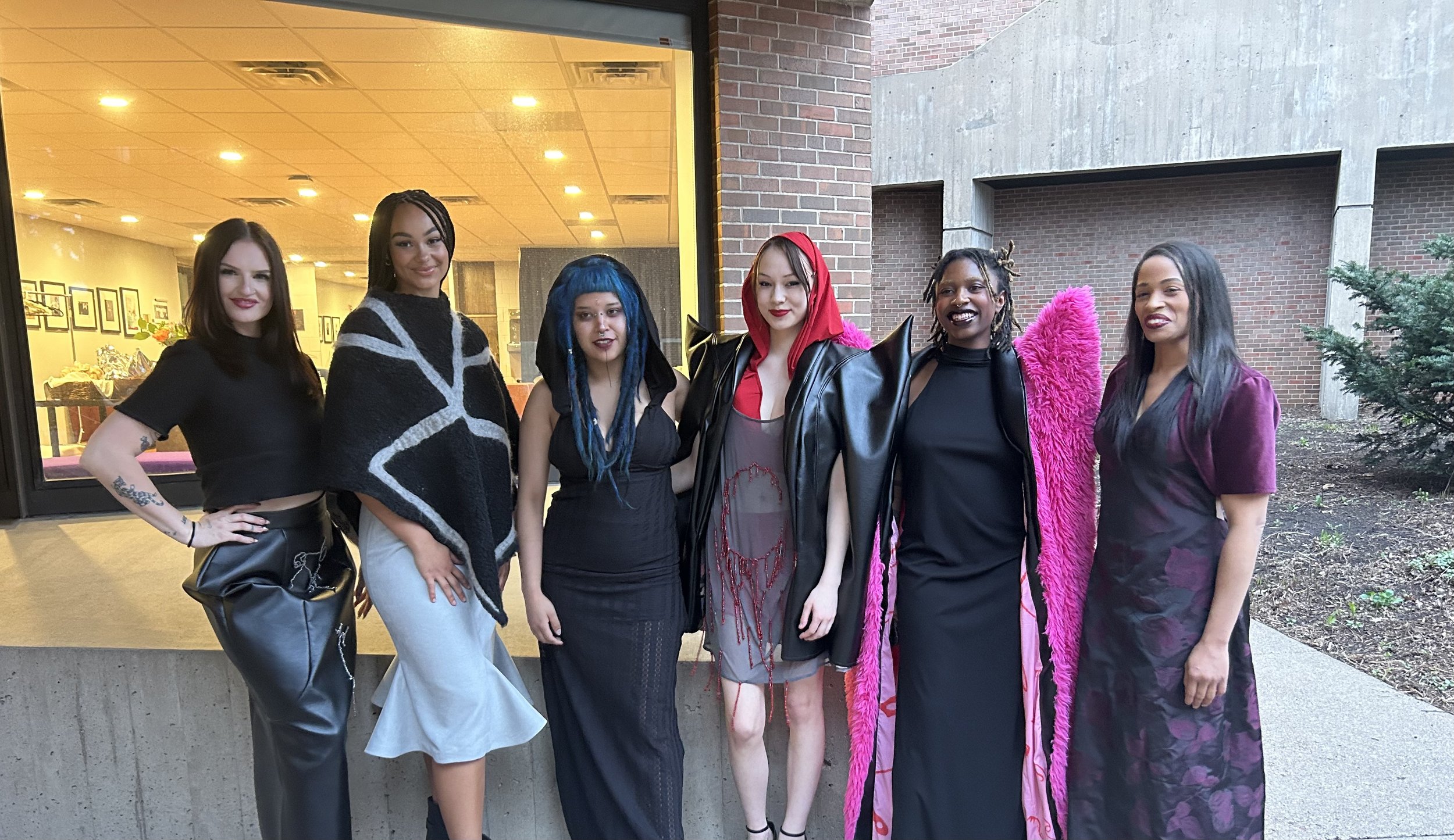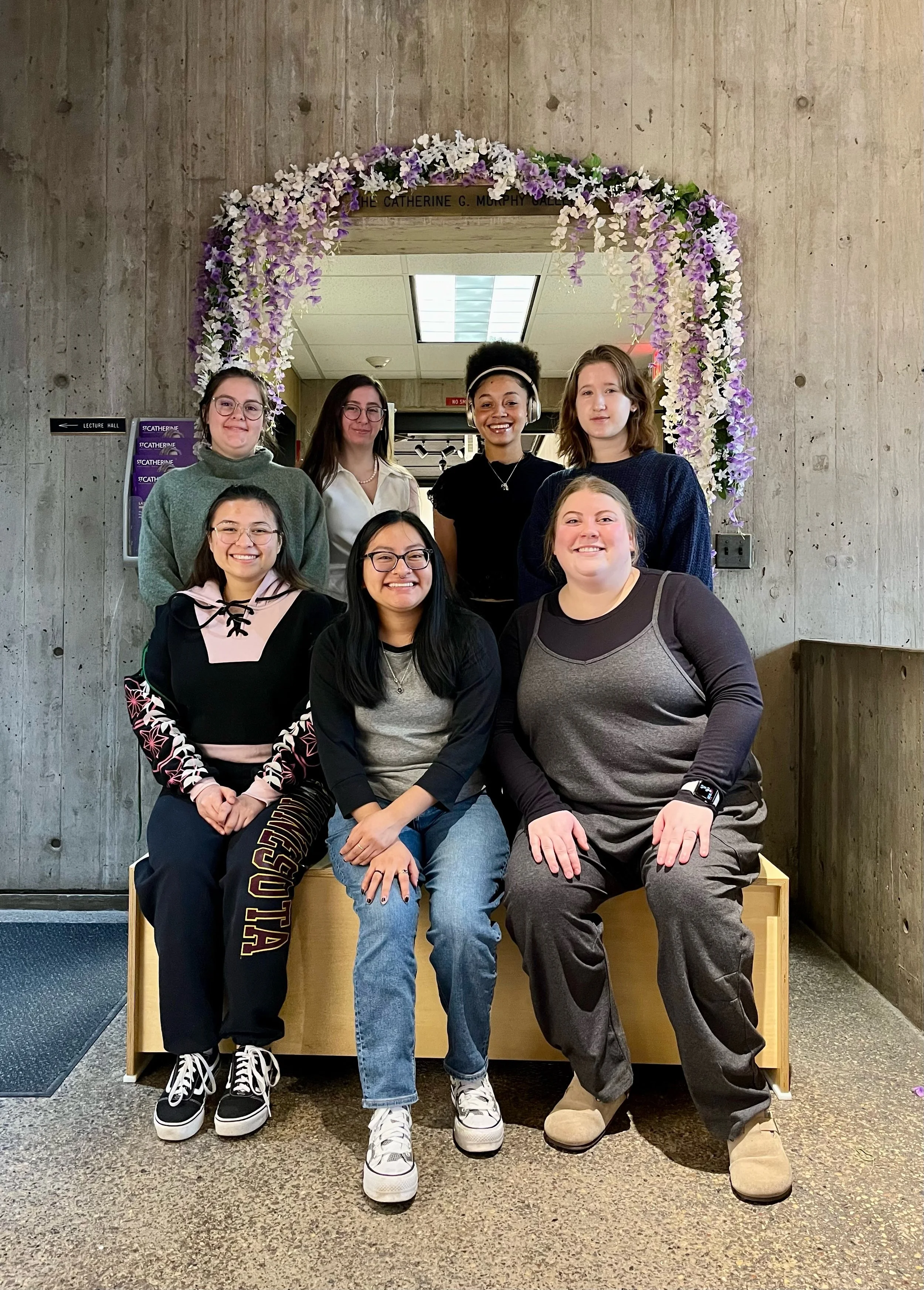Stitching together Katwalk
Cover image: The runway in the Frey Theater
By Skylar Mattson
On Saturday, April 27, St. Catherine University Fashion Association (SCUFA) held its annual Katwalk fashion show in the Frey Theater on campus. Completely student-produced, Katwalk showcased work created by students in St. Kate’s fashion design courses — including senior capstone collections, which consist of five complete ensembles (four original designs and one reengineered design). Garments ranged from upcycled looks to artisanal tailored outerwear to patterned collections, featuring a variety of styles. Overall, it was a grand celebration of the accomplishments of fashion students — and the result of many months of hard work.
I discovered what goes into putting together a fashion show when I joined SCUFA members for their last meeting before the show. I stumbled upon a small but dedicated and determined group of students working tirelessly to plan every detail of what proved to be an outstanding 21st Katwalk.
Many of these students working behind the scenes were also the students creating looks for the runway, including SCUFA co-presidents Kiara Gomes ‘25 (Fashion Design/International Studies, Sustainability Studies minor) and Veronica Wakefield-Young ’24 (Fashion Design), who displayed their senior collections at the show. These students were not letting a single detail go unnoticed, making sure to cover all their bases.
Preparation starts months before the show with negotiating to find funding, hunting for the right venue and searching for videographers and photographers. Once these big-picture items are figured out, the group can start to put together a show. This means selecting models, decorating the venue, creating programs, finding volunteers to help out, ordering catering and planning an after-party for celebrating and networking.
President Becky Roloff carrying her roses on the runway to signify that she was a featured model.
SCUFA’s hard work led to an impressive Katwalk. The students put on a show that was organized and professional, and the looks displayed were unique and innovative. In true St. Kate’s fashion, they were a celebration of environmental and social justice issues. Many of the models were familiar faces to the St. Kate’s community, including current students as well as featured model President Becky Roloff.
Two of the senior designers dedicated their lines to women’s healthcare rights and nature, respectively. They each told me all about their lines and the inspiration behind them during an interview.
“Vengeance” by Veronica Wakefield-Young
Ensemble titles from left to right: Non-Viable, Prayer from Pain, Grimm Dress, Two Liters of Blood, Viole(n)t, Surgical Safety
Wakefield-Young’s line, titled “Vengeance,” was a reflection of women’s reproductive rights in the United States healthcare system.
SM: Your line tells a story of healthcare, can you explain more?
VW-Y: When I was taking the Biology of Women class last year, and we were looking at women’s healthcare, specifically in regards to reproductive rights and some of the legislation that’s happened recently, the things that really scare me are [the] legislation where it’s not the woman’s fault. Legislation where there’s nothing else she could’ve done, legislation where if she doesn’t get the medical help, she will die. I’m not trying to tell people what to think. I had to take my rage and my disgust at some of these things, and I had to put it somewhere. It is a little bit of my personal emotional response to reading some of these legislations. I kind of want to ask the question of, “What is mercy? Where do we draw the line?”
SM: Can you tell me more about the names of your pieces?
VW-Y:
Nonviable: “It’s a term [for] when there is a pregnancy, regardless of what the medical provider is able to do, there’s no chance of life. We’re seeing right now in a lot [of] current legislation that regardless of whether the child is medically nonviable, the legislation does not regard it as such because of religious or moral perspectives.”
Prayer from Pain: “Being stuck in a situation where you are just in severe pain and you can’t get out of it. I’m not a very religious person, but when I’m in the real shit, I still find myself praying to God. That’s really changed my perspective a lot. Whether that be the fates or Greek gods or whatever have you, sometimes with severe pain, it is above us.”
Two Liters of Blood: “Two liters of blood is what classifies as a level five blood loss. That was directly inspired by the finding out that a majority of blood loss deaths could have been prevented by this plastic bag that now is being commonly used that helps measure the blood loss on the table.”
Viole(n)t: “It’s this purple-y violet color. I just have a play on words where it’s violet but it’s violent. Especially if you think about the color of bruising, domestic violence, rape, all of those things aren’t really being taken into consideration right now by the legislation.
The Grimm Dress: “The Grimm Dress really represents death. Death is something that’s inevitable. But, it doesn't have to be cruel, and you shouldn’t have to die when you’re trying to bring in life.”
The Surgical Safety Dress: “Although medical stuff really freaks me out, it’s kind of trying to celebrate medical advances in a way. We have the tools. We can save people.”
[Referring to the line as whole]: “This is my woman. She’s dealt with a lot of pain, and she’s still strong, and she’s still surviving, and she still looks hot as hell. This is my protest to life.”
“Symbiosis” by Neve Palubicki
Ensemble titles from top to bottom, left to right, with Palubicki at the very bottom: Ledovec, Anura, Papilio, Vitreu, Hyla
Neve Palubicki ’25 (Fashion Design) showed their connection to nature from being a child raised in rural Minnesota in their collection, “Symbiosis.” Each piece symbolizes a different memory from their childhood and featured Minnesota animals or lakes.
SM: Tell me about how your line connects to your childhood.
NP: My sister was born premature, so she had a lot of medical issues that needed to be taken care of. I wasn’t left alone or anything, but I definitely had more time for myself. I just found that going outside and exploring was my way of taking care of myself. Now that I’m here, I realize that those roots are really what drove me to fashion and art. I really wanted to go through and find, “What are the best memories from my childhood?” and then, make a collection off of that. I just found that the animals were always my best memory.
SM: Do you want to tell me more about the names of your pieces?
NP:
Vitreu: That’s a Latin name to describe being glassy or walleyed, which is the scientific name for the walleye, the main fish in my dress.
Hyla: The order [genus] of tree frogs, and we have two tree frog species here in Minnesota, which is incredible.
Anura: That’s the [scientific] order that all frogs fall underneath.
Papilio: I can’t remember if it’s an order [or] family of swallow-tailed butterflies because we do have a few of those here. Those are my favorite.
Ledovec: It’s the Czech word for glacier. The lakes in Minnesota are all glacial lakes. They were carved out and filled by the glaciers, so I thought that was very fitting. It’s also fitting because my name when translated to French happens to mean glacier, so I feel a very personal connection through my name.
SM: What was the process of creating this entire line?
NP: I knew I had wanted to do fish first ‘cause that was some of my first memories, just going out fishing with my dad, being at the lake. I knew for myself, I wanted to go big or go home. I wanted to create coats that weren’t just like your normal silhouette even. That’s where the butterfly jacket came in as an idea. I asked my mother to send me every single picture she had ever taken so that I could look through them to gather these memories for my collection. I’d have this bright green top and like a neon pink skirt and be like, “This is my outfit.” That is exactly what childhood me would want is for these bright complimentary, contradictory colors where it’s just like a rainbow threw up on my collection. That’s where the frog jacket set came [from]. The lake [jacket] was a very important one for me because from the beginning I knew that I wanted to do a lake map of Otter Tail County [the county they grew up in] ‘cause that’s just so special to me. I would say this whole collection was a lot of brain gymnastics, but I knew from the beginning that if it wasn’t going to be hard, and if it wasn’t going to be complicated, then, I didn’t even want to do it. I wanted to really push myself for this one.
The seniors began working on their collections in the fall, but the majority of the work was done this spring semester. To the designers, creating five to six ensembles in just a few months does not feel real.
Wakefield-Young shared, “That’s the best feeling at the end is freaking out being like, ‘I have nothing.’ And all of a sudden, you’re like, ‘Wait, there’s six things, and I made that?’ It does not feel real.
“Unreal” explains the beauty of Katwalk. It’s unreal to the designers that they created these inspiring pieces, and it’s unreal to the audience that they are seeing these innovative and intricate designs created by students.









